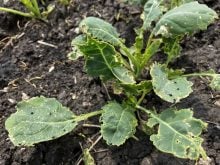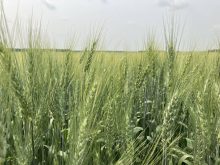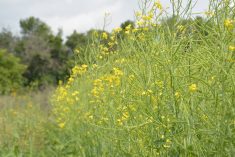Infestation puzzling | Despite best effort, Alberta farmer is still fighting the canola disease
NEW NORWAY, Alta. — Dave Trautman has grown canola three times in the last 12 years in a field overlooking the Battle River Valley.
He followed best management practices, rotated the canola with wheat and barley and kept the weeds under control.
This year he found clubroot in a corner of the field.
“I am coming out of the closet. I have clubroot,” Trautman said during a UFA field day to look at canola varieties, including those with clubroot resistance.
Trautman doesn’t know if the clubroot spores arrived on equipment, wind, water or from all-terrain vehicles driving down to the river valley.
Read Also

Farming Smarter receives financial boost from Alberta government for potato research
Farming Smarter near Lethbridge got a boost to its research equipment, thanks to the Alberta government’s increase in funding for research associations.
The clubroot isn’t in the field entrance, but in a corner, where he suspects it may have been carried by ATVs.
It doesn’t matter how it got into the field. Trautman must now manage his field knowing the clubroot spores are there.
Farmers from Hay Lakes to Meeting Creek to Flagstaff County in the east should all assume they have clubroot, he said.
“After two canola crops, how would I know I had it?” said Trautman, a former assistant agricultural fieldman with Camrose County who struggled about going public about his discovery.
“I really had to do some soul searching.”
The county hasn’t found clubroot in nearby fields, but Trautman said he found it in six canola fields within five kilometres after discovering clubroot in his field.
“I’m finding it everywhere.”
A new clubroot policy adopted by Camrose County in June encourages landowners with low levels of clubroot infestation to encourage discussion and education about best management practices, especially in fields with low infestation.
“If you find some, talk to your fieldman,” Trautman said.
Clubroot was first discovered in fields near Edmonton in 2003. The soil borne disease can dramatically reduce canola yields, especially in fields heavily infested with spores.
When clubroot was first discovered, counties and municipalities across the province implemented tough rules preventing farmers from growing canola on land with the disease.
At the same time, best management practices for clubroot control included washing equipment between fields and spraying equipment with bleach.
“They recommended spray bleach on a drill. Bleach on a $100,000 drill is bad advice,” he said.
Instead, farmers should use an air hose or a leaf blower to blow off most of the dirt and dust every time they leave the field. It’s estimated 10 to 50 pounds of dirt travels with a piece of equipment when it leaves the field, he said.
Genes for clubroot resistance became part of many canola varieties after the disease was discovered.
Going public about clubroot in his field has allowed Trautman to talk openly with his neighbours about best management practices to limit the spread of clubroot. Limiting fall tillage, growing clubroot resistant varieties, controlling volunteer weeds and limiting soil movement between fields will help limit its spread.
“I’m not happy about this, but it’s a fact of agriculture that we are in.”

















